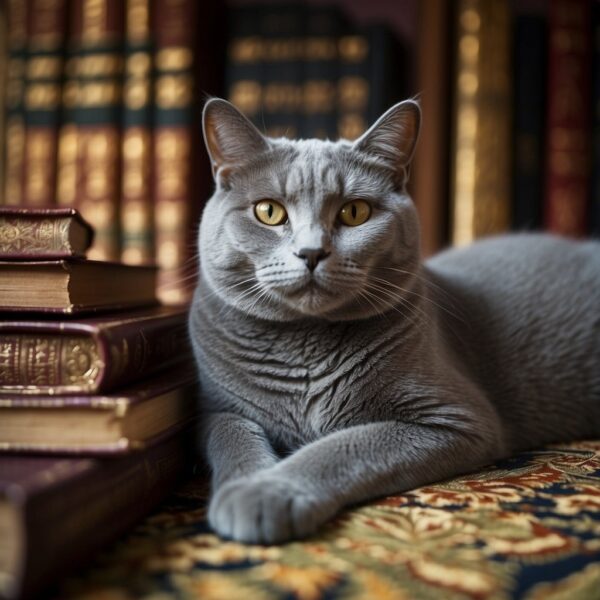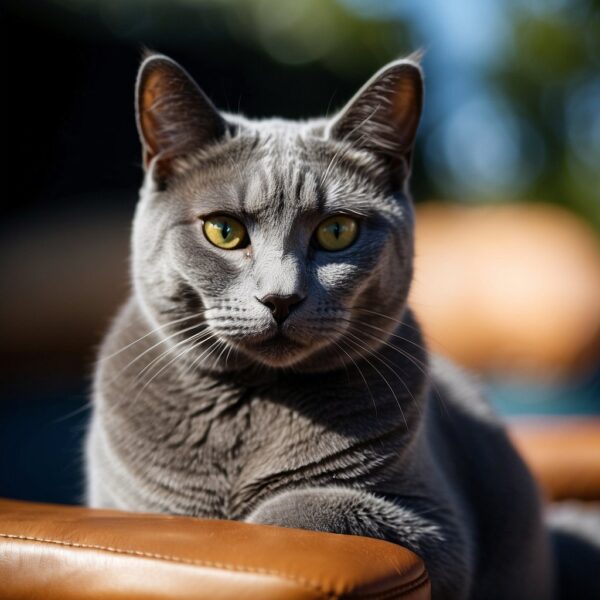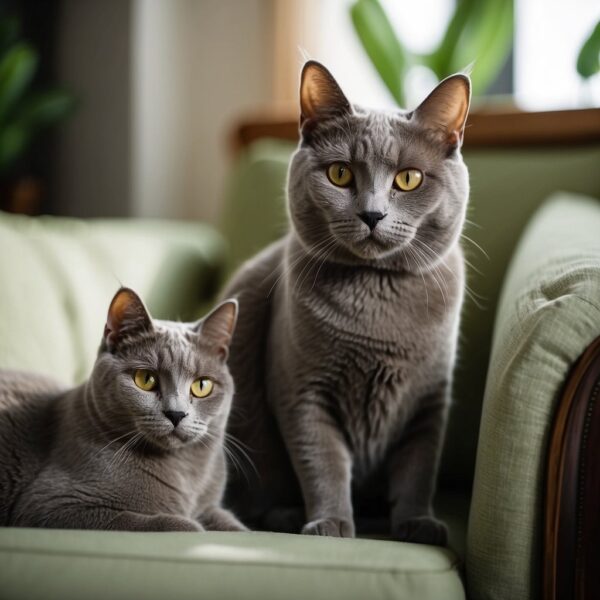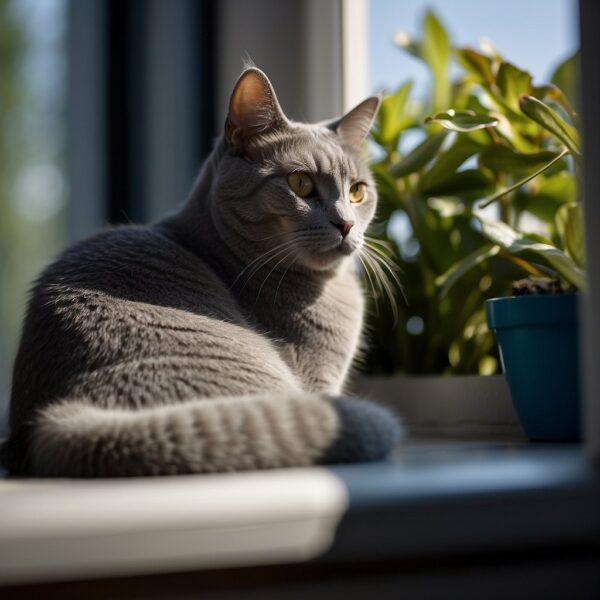
Chartreux Cats: Blue-Hued French Cats
The Chartreux cat is a historic breed renowned for its calm demeanor and physical distinctiveness, having originated in France. This French cat is celebrated not only for its affable nature but also for its robust build and characteristic blue-gray coat that possesses a uniquely woolly texture. With bright copper eyes and a quietly affectionate personality, Chartreux cats make for both striking and loving companions.
Hailing from a storied background, the Chartreux may have a history that intertwines with the Carthusian monks of France, who are credited by some legends with having bred these cats for their vermin-hunting prowess. In reality, the breed’s true origins are somewhat more mysterious, but regardless of its beginnings, the Chartreux has evolved into a large, muscular cat recognized for its agility and intellectual acuity.
Key Takeaways
- The Chartreux cat is known for its unique blue-gray coat and amiable nature.
- Its history is steeped in French heritage, possibly connected to monastic life.
- These cats exhibit a blend of muscular build, agile reflexes, and intelligent behavior.

Chartreux Cat History
The Chartreux is a breed with a tumultuous and enigmatic past, tracing back to the 16th century. Key elements of their history include their obscure origin and the breed’s fluctuating popularity.
Origin
It is often stated that the Chartreux cat originates from France with assertions linking them to the Carthusian monks of the Grande Chartreuse monastery during the 13th century. However, this theory lacks documentary evidence and was formally discounted by the Prior of the Grande Chartreuse in 1972. Instead, the breed’s true origins are shrouded in mystery, with the earliest records dating back to at least the 16th century.
Popularity
The breed was first introduced to the United States in 1971 and gained championship status by the Cat Fanciers’ Association (CFA) in 1987. As of 2007, there were fewer than two dozen active Chartreux breeders in North America. Their reputation stems from their poised appearance and placid temperament, although they remain a relatively rare choice among cat enthusiasts.
Characteristics of Chartreux cats
The Chartreux is a distinctive cat breed known for its robust physique and unique coat characteristics. This breed’s calm demeanor and physical traits have made it a beloved companion around the world.
chartreux cat Physical Appearance
The Chartreux exhibits a striking physical appearance with a robust body and fine-boned legs, creating a markedly sturdy silhouette. This breed typically has a round head with powerful jaws and a straight nose leading to a sweet, smiling expression. Adult Chartreux can have a significant variation in size, but they generally stand between 8 to 11 inches at the shoulder.
Coat and Color
Chartreux cats are adorned with a medium length coat that is dense and soft to the touch, providing excellent insulation. The coat is primarily one color:
- Blue-gray: A solid and even shade that is the hallmark of the Chartreux.
Their coat requires minimal grooming due to its ability to resist matting. A striking set of copper or orange eyes contrasts beautifully with the blue coat, enhancing the breed’s overall allure.
Physique
The physique of a Chartreux cat is robust and muscular, which has been noted to resemble “a potato on toothpicks” due to their broad shoulders and slim legs. Adult males typically weigh over 12 pounds, while females can be slightly smaller. On average, these cats can weigh:
- Male: 12-16 pounds
- Female: Less than 12 pounds
Their solid musculature implies a cat built for agility and strength, yet their movements remain graceful and elegant.

chartreux cat Behavior and Temperament
The Chartreux cat is renowned for its calm demeanor and affectionate nature, often displaying loyalty to its family while maintaining a pleasant independence.
French cat Personality Traits
- Calm and friendly: These cats are known for their serene temperament, making them suitable companions for a variety of households.
- Intelligent: Chartreux cats are quick to learn and can easily adapt to their environments, often showing a playful side.
Social Behavior
- Affectionate with family: While they form strong bonds with their human families, Chartreux cats typically choose one person as their favorite.
- Discreet companionship: They are not overly demanding of attention, preferring to stay close without being obtrusive.
Adaptability
- High adaptability: Chartreux cats are capable of adjusting well to different living conditions and are not easily stressed by new environments or changes.
- Quiet presence: Their quiet and unassuming nature makes them well-suited for various living situations, from apartments to larger homes.
French cat breed Health and Care
Maintaining the health and care of a Chartreux cat requires attention to potential breed-specific health issues, a balanced diet, and regular grooming due to their unique coat.
Common Health Issues
Chartreux are generally healthy, but they can be prone to certain health issues. Cardiomyopathy, a heart condition, and kidney disease have been observed in the breed. Regular veterinary check-ups are essential to monitor and manage these conditions.
Dietary Needs
The Chartreux’s diet should be high-quality and protein-rich to sustain their muscular bodies. Monitor their food intake to prevent obesity, which can exacerbate health problems. Adequate hydration is equally important, so fresh water should always be available.
Grooming Requirements
Chartreux cats have a distinct blue-gray coat with a woolly texture that necessitates regular grooming. Weekly brushing is recommended to remove loose fur and prevent matting. During shedding seasons, more frequent grooming may be necessary to keep their fur in good condition.

Breeding and Genetics
Chartreux cats possess a unique genetic makeup that influences their physical attributes and robust health. This section explores the genetic traits that characterize the breed and the established breeding standards that guide the preservation of their lineage.
Genetic Traits
The Chartreux cat is genetically inclined to have a robust and muscular physique paired with a remarkably dense, water-repellent coat. Their genetic blueprint often results in a short to medium-length blue-gray fur, giving them a distinctive appearance. Furthermore, they typically have bright orange or copper eyes, a trait that is favored and perpetuated through selective breeding. Characteristically, these cats have a mutation that gives them a quiet or silent meow, which is a breed-specific trait.
French cat Breeding Standards
Breeding Chartreux cats adheres to strict standards to maintain the breed’s integrity. Breeders prioritize health and specific physical characteristics aligned with the breed’s historic lineage.
- Coat Color: The standard necessitates a uniform blue-gray color with a preference for a medium to bright shade.
- Body Type: The breed should exhibit a sturdy, medium to large build, well-muscled, with broad shoulders and a deep chest.
- Head Shape: A rounded head with full cheeks and a straight nose is ideal according to the breed standard.
These standards were crafted to ensure that the Chartreux retain their traditional, distinct appearance and robust health. Breeders must work within these guidelines to preserve the breed’s unique genetic traits.
Chartreux in Culture
The Chartreux has made a subtle but indelible mark on culture, primarily within literature and art, and extending its influence into modern media.
Literature and Art
Literature: This French cat breed has enjoyed literary mentions reflecting its long history. The Chartreux is often shown in a positive light, celebrated for its elegant appearance and gentle temperament.
Art: Historically, Chartreux cats have been depicted in paintings and tapestries. Their distinctive blue-grey coats and striking orange eyes often serve as a muse for artists who appreciate the breed’s serene and dignified presence.
Modern Media
The Chartreux’s influence extends into contemporary media. They are sometimes featured in television and film, often embodying characteristics of grace and composure. In animated media, the Chartreux’s unique features are sometimes exaggerated for artistic effect, yet they continue to be represented as endearing and intelligent characters.

Frequently Asked Questions
Chartreux cats are known for their amicable personalities, notable blue-gray coats, and bright copper eyes. Below are some frequently asked questions to help prospective owners understand this unique breed better.
What is the typical personality of a Chartreux cat?
Chartreux cats typically exhibit a gentle and affectionate personality. They are known to be quiet and good-natured, making them excellent companions.
How long is the average lifespan of Chartreux cats?
The average lifespan of a Chartreux cat ranges from 12 to 15 years, though some can live even longer with proper care.
What are common coat colors for Chartreux cats?
Chartreux cats are recognized for their uniform blue-gray coats which have a woolly texture, giving them a distinctive plush appearance.
What type of diet is recommended for Chartreux cats?
A balanced diet rich in protein is recommended for Chartreux cats, as it supports their muscular build and overall health. It’s important to monitor their food intake to prevent obesity.
How do Chartreux cats generally behave around people and other pets?
Chartreux cats are usually sociable and can get along well with children, adults, and other pets when properly introduced. They are adaptable and can thrive in various household settings.
What is the average cost to purchase a Chartreux cat?
The cost to purchase a Chartreux cat can vary widely but typically ranges from $1,000 to $1,500 from reputable breeders. Prices can fluctuate based on pedigree, location, and breeder reputation.